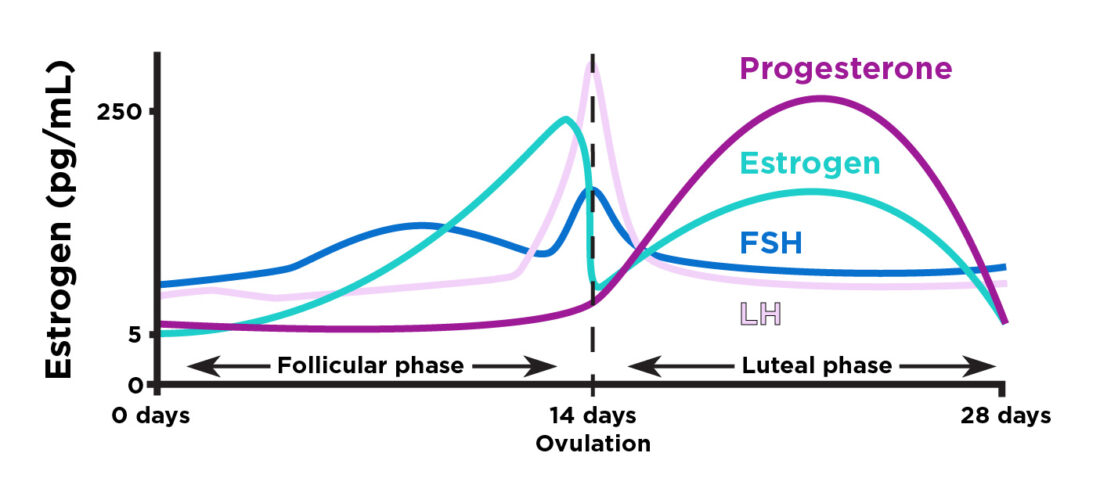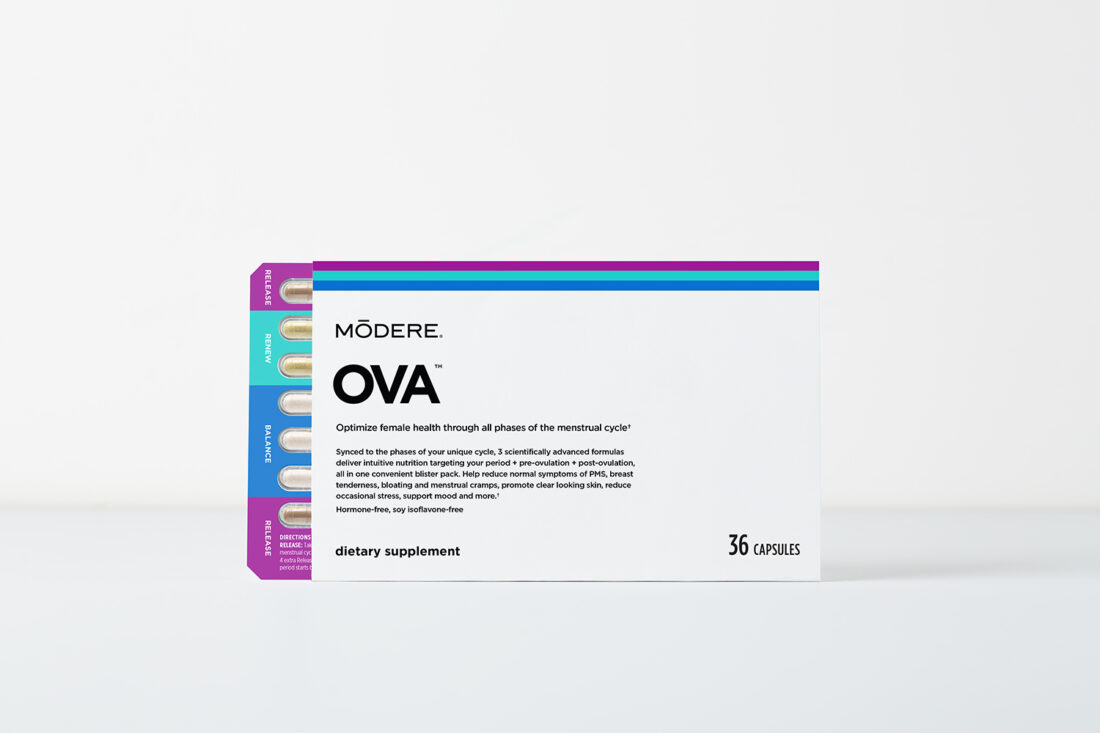When it comes to female health, many women think they know what’s happening in their bodies. Whether you learned about your sexual health from a parent, health class or school maturation program, the gist is the same: You ovulate and if an egg isn’t fertilized your uterine lining sheds. Rinse. Repeat.
And along with this cycle come the normal menstrual symptoms we’re all familiar with, like mild PMS, occasional bloating, mood swings, skin congestion and more. Most of us blame our hormones for causing these ups and downs, but the truth is hormones only tell part of the story of what’s actually going on inside your body. In other words, the normal menstrual symptoms that you experience might not originate from where you think.
The latest science indicates that throughout your menstrual cycle, over 200 micronutrients in your body fluctuate between your period, pre-ovulation and post-ovulation. What’s more, 67 of these micronutrients may be directly tied to normal menstrual symptoms. While hormonal birth control is often prescribed as the default method for addressing these symptoms, it fails to address what’s happening in your body at the nutritional level.
Which is what, exactly?…
Let’s take a closer look at what happens during each phase of your menstrual cycle on a hormonal level and on a nutritional level — and break down why it matters.
WHAT REALLY HAPPENS DURING YOUR MENSTRUAL CYCLE

Days 1-4: Period/Menstruation
Day 1 of your menstrual cycle is the first day of your period, the day you first start bleeding. The length of your period may vary; 2-7 days is the normal range, and most women report heaviest bleeding on the second day.
Hormonal Fluctuations
Mild period cramps are likely caused by a hormone-like substance called prostaglandin. When it triggers your uterus to shed its lining, it contributes to uterine contractions that might have you reaching for a heating pad. What about mood swings, food cravings and brain fog? With estrogen, progesterone and serotonin (a “happy hormone”) at all-cycle lows on Day 1 of your period, it’s no wonder you don’t feel like yourself!*
Nutrient Fluctuations
Prostaglandin, sex hormones and serotonin aren’t the only factors contributing to normal period symptoms. During your period, levels of key organic acids essential for energy metabolism and the absorption of other minerals drop. This can make you feel tired and prone to occasional mild abdominal cramps — especially if your body isn’t optimally absorbing minerals like magnesium, copper, potassium and B vitamins essential to healthy blood flow.*
Days 5-16: Pre-Ovulation/Follicular Phase
Your follicular phase technically starts the same day as your period, but most women begin to notice shifts in their bodies associated with the follicular phase — like improved mood, more energy and focus, and higher libido — around the fifth day of the menstrual cycle. The follicular phase lasts until ovulation, which is why this phase is also referred to as pre-ovulation or pre-ovulatory.*
Hormonal Fluctuations
During the follicular phase, most women report an improvement in mood, more energy and better mental focus. This is attributed to increases in estrogen and testosterone, which build over the course of about 2 weeks from your period leading up to ovulation.*
Nutrient Fluctuations
In addition to increased levels of estrogen, lipid levels reach an all-cycle high leading up to ovulation. Lipids are crucial to your body’s energy levels, help regulate hormones, transmit nerve signals, cushion organs and signal your body’s fat stores. Was your bleeding occasionally heavy during menstruation? While the average woman only loses up to 3 tablespoons of blood during her period, some women may benefit from extra iron during the follicular phase.*
Day 17-First Day of Your Next Period: Luteal Phase
The luteal phase varies in length for all women. It is the phase between when you ovulate and when your next period begins. Because it occurs after ovulation, this phase is often referred to as post-ovulation or post-ovulatory.
Hormonal Fluctuations
The luteal phase might as well be known as the PMS phase because it’s when you’re most likely to notice mild PMS symptoms like breast tenderness, mood swings and occasional bloating, as well as skin congestion and overall oilier skin and hair. What gives? As soon as ovulation occurs, estrogen drops dramatically, and your ovaries pump up the hormone progesterone.*
Nutrient Fluctuations
Estrogen isn’t the only biochemical marker taking a nosedive in the luteal phase. Scientific evidence indicates women experience the most significant drop in a wide range of nutrients post-ovulation, including amino acids like serotonin, organic acids and several lipids. These fluctuations contribute to physical symptoms like mild cramps, breast tenderness, skin congestion and fatigue, as well as cognitive symptoms like mood swings and brain fog. Extra zinc can help clear skin and targets mild cramping, while support for the endocannabinoid system helps reduce normal symptoms attributed to lipid metabolism.*
If it seems like a lot of information to digest, you’re not wrong! And until now, there hasn’t been an easy and effective way to help reduce normal menstrual symptoms without directly affecting your hormone balance. Not only does a nutrition-focused approach help support your body without directly acting on your hormones (unlike hormonal birth control), but it also offers a more comprehensive, intuitive approach to optimal female health.*
#RethinkYourHormoneStory

Formulated for women, by women, patent-pending Modere Ova™ delivers intuitive nutrition synced to the phases of your menstrual cycle and supports optimal female health without hormones.*
All 3 potent formulas — RELEASE, RENEW and BALANCE— are packaged in one easy-to-use blister pack that clearly outlines when to take each one to align with your menstrual cycle daily, and is easily customizable with your unique cycle length.
RELEASE is taken the first 4 days of the menstrual cycle, starting on the first day you bleed. Its role is to support the body’s natural detoxification process and support energy levels, healthy blood flow and iron metabolism.*
Formulated with Menstrual D-Tox Complex™, RELEASE delivers over a dozen nutrients and botanicals to support you during your period, including essential vitamins and minerals copper, niacinamide, potassium and magnesium, plus antioxidant CoQ10*.
RENEW supports female health as your body prepares for ovulation and ovulates. Taken days 5-16, it supports hormones and helps optimize energy levels and mood.*
Formulated with Bio-Optimal Pre-Ov Blend™, RENEW delivers a potent formulation of ingredients like inositol, shown to support healthy levels of hormones insulin, dopamine and serotonin already within normal range, highly bioavailable and ion-neutral iron shown to absorb in the digestive tract without gastrointestinal upset, plus iodine, adaptogenic maca and more.*
BALANCE provides support during post-ovulation from day 17 until your next period starts. Its primary role is to help reduce normal and mild symptoms of PMS like mood swings, congested skin, breast tenderness and bloating, and helps enhance the absorption of key nutrients from your diet as your body prepares for its next period.*
BALANCE supports the endocannabinoid system with PEA, a highly bioavailable fatty acid amide, along with several other nutrients and botanicals in its Co-Active PMS Matrix™. Other star ingredients include highly bioavailable apple and ancient peat polyphenols shown to increase blood levels of ATP by up to 64% to support cellular health, a micro-encapsulated, bioavailable melon concentrate shown to reduce occasional stress by 22%, and two forms of highly bioavailable zinc to support clear looking skin.*
Now that you really know what happens during your menstrual cycle and why it matters, it’s time to #RethinkYourHormoneStory and optimize female health with Modere Ova. Not only does Ova deliver a more intuitive approach, but it also allows you to biohack your daily wellbeing by taking the guesswork out of your cycle. And for women in perimenopause, menopause or post-menopause, try Modere Ova™-m.
Ova is recommended for menstruating women ages 18+ not using hormonal birth control. Its ingredients are generally considered to be safe for women taking birth control to use, however birth control users may not experience as many noticeable benefits because hormonal birth control typically prevents ovulation. Ova does not replace a prenatal vitamin for pregnant women. If you become pregnant, discontinue use. Consult your doctor before starting any supplement regimen.
| *These statements have not been evaluated by the Food and Drug Administration. This product is not intended to diagnose, treat, cure or prevent any disease. |









